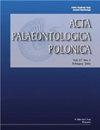The reinstated identity of agglutinated foraminifer Campanellula capuensis from the Lower Cretaceous of southern Italy by means of a 3D model investigation.
IF 1.9
3区 地球科学
Q2 PALEONTOLOGY
引用次数: 0
Abstract
Campanellula capuensis was described as belonging to the Trochamminacea (trochospiral tests) and later transferred to the genus Orbitolinopsis of the Orbitolinidae (uniserial tests). Challenging its identity as a species of Orbitolinopsis , the most widely accepted classifications of agglutinated foraminifera reinstate Campanellula but retain its inclusion within the Orbitolinidae, subfamily Dictyoconinae. New material from the type locality and the San Lorenzello section (Matese Mountains, southern Apennines, Italy) as well as the construction of a 3D model allow to reinstate the original description as a low-to high-trochospirally (conical) coiled foraminifer with numerous chambers per whorl and to display an overall conical test morphology. An orbitolinid test construction including uniserial chambers (throughout the test or in its adult part) is absent. The conflicting opinions on taxonomic status of Campanellula are discussed leading to the removal from the order Loftusiina and the suborder Orbitolinina. Instead, Campanellula should be included into the order Lituolida and the suborder Verneuilinina. Campanellula capuensis represents a biostratigraphic and palaeobiogeographic marker taxon, restricted to upper Hauterivian–lower Barremian inner platform carbonates of the southern Neotethyan margin.意大利南部下白垩纪粘连有孔虫Campanellula capuensis的身份恢复通过三维模型调查。
Campanellula capuensis被描述为属于Trochamminacea (trocho螺旋试验),后来被转移到Orbitolinopsis属的Orbitolinidae(单次试验)。最广泛接受的粘连有孔虫分类恢复了Campanellula,但保留了其在眶孔虫科Dictyoconinae亚科中的地位,挑战了其作为眶孔虫的一种的身份。来自类型地区和San Lorenzello剖面(意大利亚平宁山脉南部的Matese山脉)的新材料以及3D模型的构建允许恢复原始描述为低到高的trochospirally(圆锥形)盘卷有孔虫,每个螺旋有许多腔室,并显示整体圆锥形测试形态。没有包括单列腔的眶线试验结构(整个试验或其成人部分)。讨论了关于钟属植物分类地位的不同观点,导致其从Loftusiina目和Orbitolinina亚目中分离出来。相反,Campanellula应该被归入Lituolida目和Verneuilinina亚目。Campanellula capuensis是一个生物地层学和古生物地理标志分类群,局限于新特提斯南部边缘的上hauteriian -下Barremian内台地碳酸盐岩。
本文章由计算机程序翻译,如有差异,请以英文原文为准。
求助全文
约1分钟内获得全文
求助全文
来源期刊

Acta Palaeontologica Polonica
地学-古生物学
CiteScore
2.80
自引率
5.60%
发文量
36
审稿时长
12.5 months
期刊介绍:
Acta Palaeontologica Polonica is an international quarterly journal publishing papers of general interest from all areas of paleontology. Since its founding by Roman Kozłowski in 1956, various currents of modern paleontology have been represented in the contents of the journal, especially those rooted in biologically oriented paleontology, an area he helped establish.
In-depth studies of all kinds of fossils, of the mode of life of ancient organisms and structure of their skeletons are welcome, as those offering stratigraphically ordered evidence of evolution. Work on vertebrates and applications of fossil evidence to developmental studies, both ontogeny and astogeny of clonal organisms, have a long tradition in our journal. Evolution of the biosphere and its ecosystems, as inferred from geochemical evidence, has also been the focus of studies published in the journal.
 求助内容:
求助内容: 应助结果提醒方式:
应助结果提醒方式:


